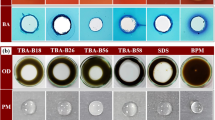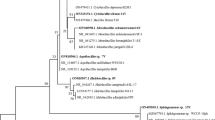Abstract
Consortia of used lubricating oil-degrading bacteria were isolated from oil-contaminated soil. The most active consortia in the assimilation of used lubricating oil were SC-9. This consortia contained four bacterial isolates based on culture-dependent technique. They were identified as Agrobacterium tumefaciens, Bacillus cereus, Chryseobacterium sp., and Sphingobacterium multivorum based on 16S rDNA sequence analysis. The SC-9 consortia showed 40.5% oil-degrading activity within 7 days. The addition of molasses to the liquid medium had a positive effect and there was an increase in the percentage of oil degradation and a greater in reduction surface tension. The ability of selected bacteria to degrade oil increased in a comparable trend as its biosurfactant production increased. Oil-degrading bacterial isolates that display substantial potential for production of biosurfactants can be applied in the bioremediation of soils contaminated with petroleum hydrocarbons.





Similar content being viewed by others
References
Ausma S, Edwards GC, Fitzgerald-Hubble CR, Halfpenny-Mitchell L, Gillespie TJ, Mortimer WP (2002) Volatile hydrocarbon emissions from a diesel fuel contaminated soil bioremediation facility. Air Waste Manage Assoc 52:769–780
Barkay T, Navon-Venezia S, Ron EZ, Rosenberg E (1999) Enhancement of solubilization and biodegradation of polyaromatic hydrocarbons by the bioemulsifier alasan. Appl Environ Microbiol 65:2697–2702
Bento FM, Camargo FA, Okeke BC, Frankenberger WT (2005) Diversity of biosurfactant producing microorganisms isolated from soils contaminated with diesel oil. Res Microbiol 160:249–255
Cameotra SS, Singh P (2008) Bioremediation of oil sludge using crude biosurfactants. Int Biodet Biodegr 62:274–280
Clemente AR, Anazawa TA, Durrant LR (2001) Biodegradation of polycyclic aromatic hydrocarbons by soil fungi. Braz J Microbiol 32:255–261
Cooper DG, Goldenberg BG (1987) Surface-active agents from two Bacillus species. Appl Environ Microbiol 53:224–229
Das K, Mukherjee AK (2007) Crude petroleum-oil biodegradation efficiency of Bacillus subtilis and Pseudomonas aeruginosa strains isolated from a petroleum-oil contaminated soil from North-East India. Bioresource Technol 98:1339–1345
Fuchedzhieva N, Karakashev D, Angelidaki I (2008) Anaerobic biodegradation of fluoranthene under methanogenic conditions in presence of surface-active compounds. J Hazard Mater 153:123–127
Guerin TF (2002) Heavy equipment maintenance wastes and environmental management in the mining industry. J Environ Manag 66:185–199
Ijah UJJ, Ukpe LI (1992) Biodegradation of crude oil by Bacillus strains 28A and 61B isolation from oil spilled soil. Waste Manag 12:55–60
Ilori MON, Amund DI (2001) Production of a peptidoglycolipid bioemulsifier by Pseudomonas aeruginosa grown on hydrocarbon. Z Naturforsch 56:547–552
Jacques RJS, Okeke BC, Bento FM, Teixeira AS, Peralba MCR, Camargo FAO (2008) Microbial consortium bioaugmentation of a polycyclic aromatic hydrocarbons contaminated soil. Bioresource Technol 99:2637–2643
Johnsen AR, Wick LY, Harms H (2005) Principles of microbial PAH degradation in soil. Environ Pollut 133:71–84
Joshi S, Bharucha C, Desai AJ (2008) Production of biosurfactant and antifungal compound by fermented food isolate Bacillus subtilis 20B. Bioresource Technol 99:4603–4608
Kim SH, Lim EJ, Lee SO, Lee JD, Lee TH (2000) Purification and characterization of biosurfactants from Nocardia sp. L-417. Biotechnol Appl Biochem 31:249–253
Krishna KR, Philip L (2008) Biodegradation of mixed pesticides by mixed pesticide enriched cultures. J Environ Sci Health B 44:18–30
Lin Y, Cai LX (2008) PAH-degrading microbial consortium and its pyrene-degrading plasmids from mangrove sediment samples in Huian, China. Mar Pollut Bull 57:703–706
Makkar RS, Cameotra SS (2002) An update on the use of unconventional substrates for biosurfactant production and their new application. Appl Microbiol Biotechnol 58:428–434
Mercade ME, Monleon L, de Andees C, Rodon I, Martinez E, Espuny MJ, Manresa A (1996) Screening and selecting of surfactant-producing bacteria from waste lubricating oil. J Appl Bacteriol 81:161–166
Miller L, Dykes L, Polesky A (1988) Procedure for DNA isolation from nuclear cells. Nucl Acids Res 16:1215
Mukherjee AK, Das K (2005) Correlation between diverse cyclic lipopeptides production and regulation of growth and substrate utilization by Bacillus subtilis strains in a particular habitat. FEMS Microbiol Ecol 54:479–489
Okerentugba PO, Ezeronye OU (2003) Petroleum degrading potentials of single and mixed microbial cultures isolated from rivers and refinery effluent in Nigeria. Afr J Biotechnol 2:288–292
Rodrigues LR, Teixeira JA, vander Mei HC, Oliveira R (2006) Isolation and partial characterization of a biosurfactant produced by Streptococcus thermophilus A. Colloids Surf B Biointerf 53:105–112
Rosenberg E, Ron EZ (1997) Bioemulsans: microbial polymeric emulsifier. Curr Opin Biotechnol 8:313–316
Rosenberg M, Rosenberg E (1985) Bacterial adherence at the hydrocarbon-water interface. Oil Petrochem Pollut 2:155–162
Sharma BK, Sarowha SLS, Bhagat SD, Tiwari RK, Gupta SK, Venkataramani PS (1998) Hydrocarbon group type analysis of petroleum heavy fraction using the TLC/FID technique. Fresenius J Anal Chem 360:539–544
Szoboszlay S, Atzel B, Kukolya J, Toth EM, Marialigeti K, Schumann P, Kriszt B (2008) Chryseobacterium hungaricum sp. nov., isolated from hydrocarbon-contaminated soil. Int J Syst Evol Micr 58:2748–2754
Tamura K, Dudley J, Nei M, Kumar S (2007) MEGA4: Molecular evolutionary genetics analysis (MEGA) software version 4.0. Mol Biol Evol 24:1596–1599
Thavasi R, Jayalakshmi S, Balasubramaniam T, Banat IM (2008) Production and characterization of a glycolipid biosurfactant from Bacillus megaterium using economically cheaper sources. World J Mircob Biot 24:917–925
Thaniyavarn J, Roongsawang N, Kameyama T, Haruki M, Imanaka T, Morikawa M, Kanaya S (2003) Production and characterization of biosurfactants from Bacillus licheniformis F2.2. Biosci Biotechnol Biochem 67:1239–1244
Willumsen PA, Johansen JE, Karlson U, Hansen BM (2005) Isolation and taxonomic affiliation of n-heterocyclic aromatic hydrocarbon-transforming bacteria. Appl Microbiol Biotechol 67:420–428
Wong JWC, Fang M, Zhao Z, Xing B (2004) Effect of surfactants on solubilization and degradation of phenenthrene under thermophilic conditions. J Environ Qual 33:2015–2025
Ye YF, Min H, Lu ZM (2006) Monitoring impact of mefenacet treatment on soil microbial communities by PCR-DGGE fingerprinting and conventional testing procedures. J Environ Sci 18:373–378
Zhang RI, Huang GQ, Lian JY, Li XG (2007) Degradation of MTBE and TBA by a new isolate from MTBE-contaminated soil. J Environ Sci 19:1120–1124
Zhou M, Rhue RD (2000) Screening commercial surfactants suitable for remeditating DNAPL source zones by solubility. Environ Sci Technol 34:1985–1990
Acknowledgements
This work was supported by the TRF/BIOTEC Special Program for Biodiversity Research and Training grant BRT R_150005 and the Graduate school, Prince of Songkla University. This research project was also funded by a grant from Prince of Songkla University through Contract No. AGR5111990022S.
Author information
Authors and Affiliations
Corresponding author
Rights and permissions
About this article
Cite this article
Saimmai, A., Kaewrueng, J. & Maneerat, S. Used lubricating oil degradation and biosurfactant production by SC-9 consortia obtained from oil-contaminated soil. Ann Microbiol 62, 1757–1767 (2012). https://doi.org/10.1007/s13213-012-0434-7
Received:
Accepted:
Published:
Issue Date:
DOI: https://doi.org/10.1007/s13213-012-0434-7




